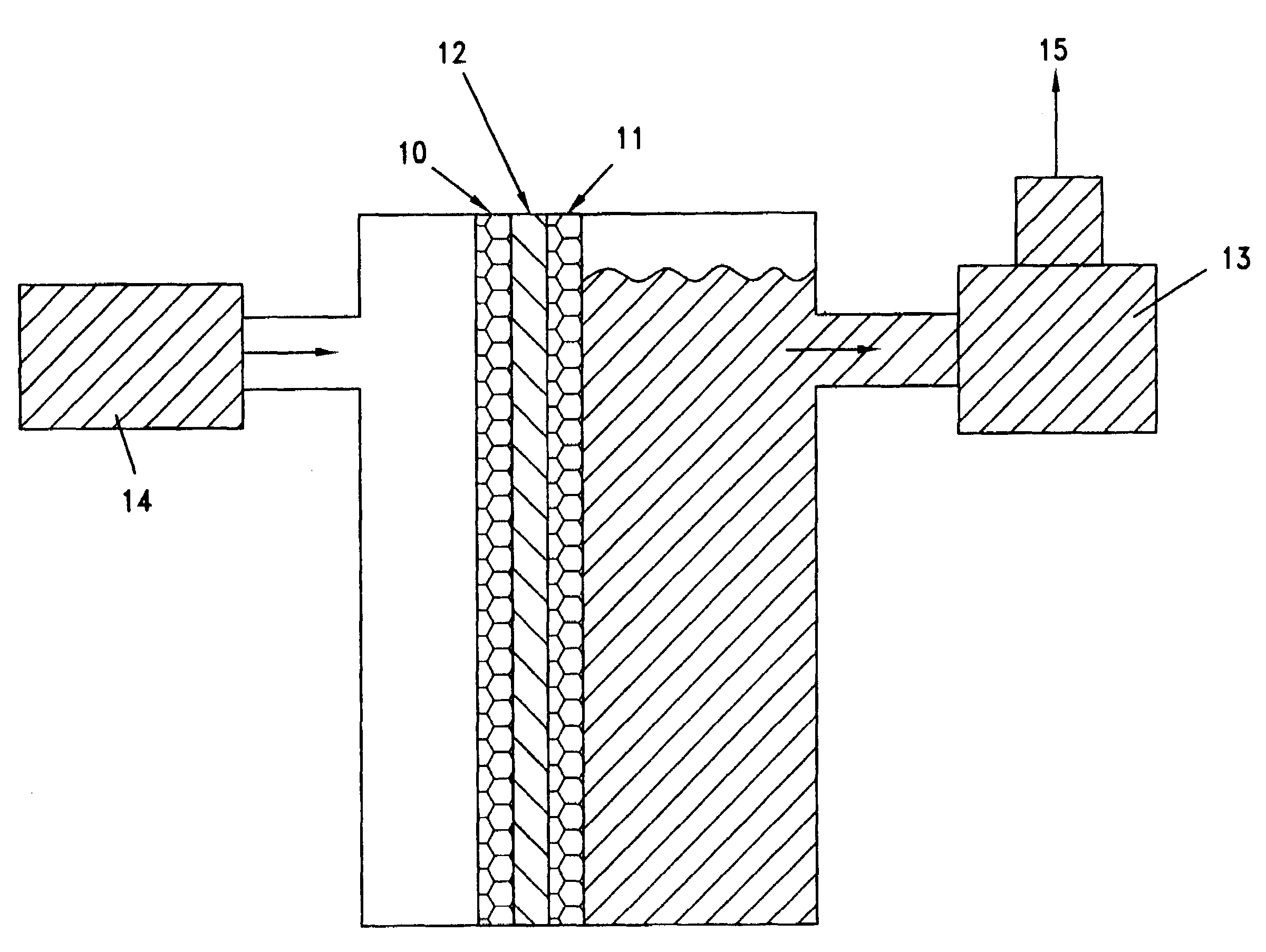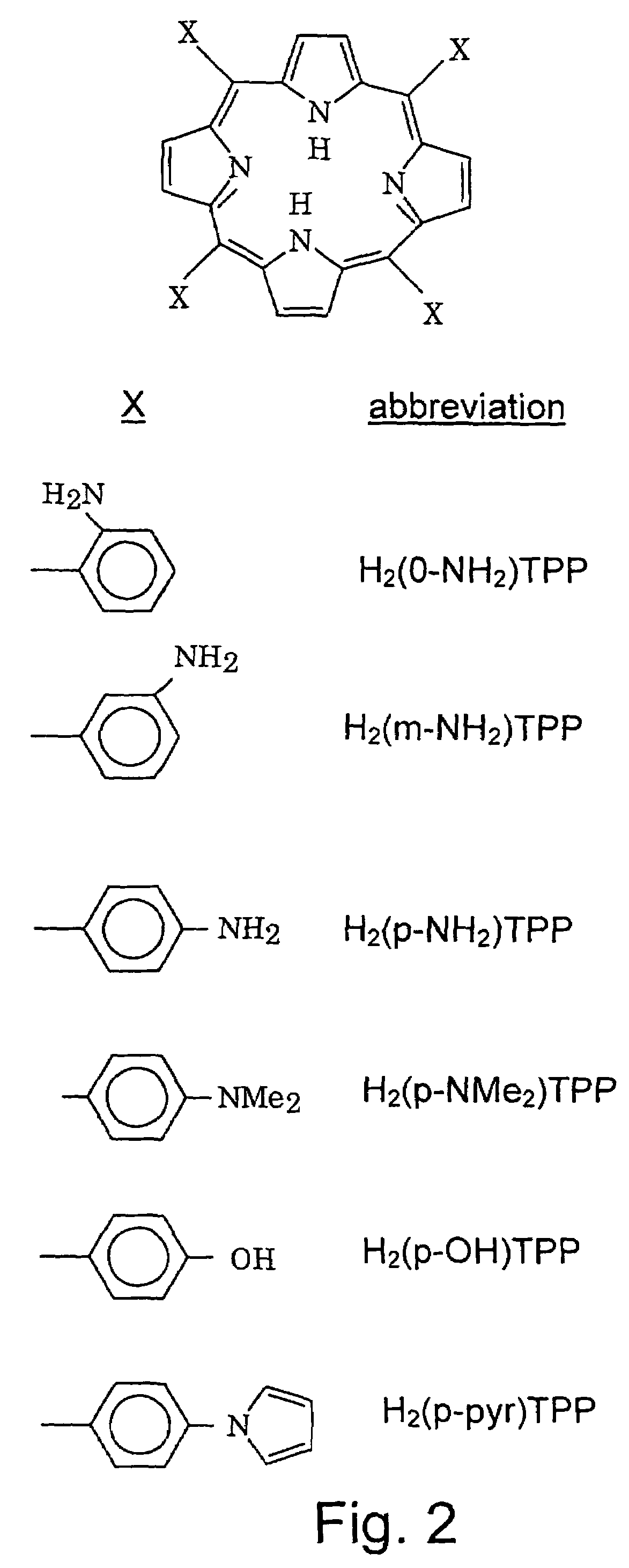Methanol fuel cells
- Summary
- Abstract
- Description
- Claims
- Application Information
AI Technical Summary
Benefits of technology
Problems solved by technology
Method used
Image
Examples
example 1
[0050]Experimental set-up: The experiment was conducted in a conventional three-electrode cell (half-cell configuration). One of two glassy carbon electrodes cast in Teflon and supplied by Metrohm(Switzerland) (A=0.07 cm2) (abbreviated: A and B) served as working electrode, a Pt wire in a separate compartment served as counter electrode and a saturated calomel electrode (SCE) as reference electrode. Potential was applied between the working and reference electrodes using a 273 potentiostat (EG&G).
[0051]Treatment and coating of working electrodes: Electrodes A and B were first polished with a water emulsion of 0.3μ alumina and then coated with Pt (as an oxygen reduction catalyst) by applying a current of 5 mA / cm2 for 10 minutes from an 10−2 M H2PtCl6+1 M H2SO4 solution at room temperature. Electrode A was then coated with an electropolymerized film of (o-NH2)TPP (abbreviated: poly(o-NH2)TPP) by cycling the potential 20 cycles from 0 to +1.2 V at a scan rate of 50 mV / s from a solution...
example 2
[0053]Experimental set-up: The same experimental set-up (half-cell configuration) as described in Example 1 was used.
[0054]Treatment and coating of working electrodes: The glassy carbon electrodes A and B were polished and then coated with Pt as in Example 1. Electrode A was then coated with poly(o-NH2)TPP by stepping the potential 30 times from 0 (10 s) to +1.2 V (60 s) from a solution of H2(o-NH2)TPP dissolved in 1M H2SO4 (1 mg / ml) at 60° C. Electrode B was not coated with this film.
[0055]Results: FIG. 4A shows oxygen reduction polarization curves (at a scan rate of 5 mV / s) obtained in 1M H2SO4 solution at 70° C. continuously bubbled with air (100 cc / min) for electrode A in the absence (curve a) and presence of 0.5 M methanol (curve b).
[0056]FIG. 4B shows oxygen reduction polarization curves (5 mV / s) obtained in the same solution and conditions as in FIG. 3 for electrode B in the absence (curve a) and presence of 0.5 M methanol (curve b).
[0057]Table I summarizes the currents obtai...
example 3
[0060]Experiments with commercially available cathodes and anodes for fuel cells were conducted first in a three-electrode (half cell) and then with a two-electrode (full cell) configuration set-up. Example 3 describes an experiment conducted with a commercially available cathode. In the two-electrode experiment, the cell used was not as illustrated in FIG. 1: a solution of acid was used as the electrolyte instead of a solid polymer membrane, and the same setup was used as for the three-electrode experiment setup, but the counter and reference electrodes were short-circuited.
[0061]Half-cell experimental set-up: The three-electrode set-up was similar to that of experiments 1 and 2. However, the working electrode used in this experiment was a commercially available electrode supplied by E-TEK: EFCG “S” Type Electrode on TGFH-120 Toray Carbon Paper, 10% Pt / C, 0.5 mg / cm2 Pt loading. Part of the electrode was brushed with masking paint so that only 1 cm2 was exposed to the electrolytic s...
PUM
| Property | Measurement | Unit |
|---|---|---|
| Fraction | aaaaa | aaaaa |
| Fraction | aaaaa | aaaaa |
| Fraction | aaaaa | aaaaa |
Abstract
Description
Claims
Application Information
 Login to View More
Login to View More - R&D
- Intellectual Property
- Life Sciences
- Materials
- Tech Scout
- Unparalleled Data Quality
- Higher Quality Content
- 60% Fewer Hallucinations
Browse by: Latest US Patents, China's latest patents, Technical Efficacy Thesaurus, Application Domain, Technology Topic, Popular Technical Reports.
© 2025 PatSnap. All rights reserved.Legal|Privacy policy|Modern Slavery Act Transparency Statement|Sitemap|About US| Contact US: help@patsnap.com



